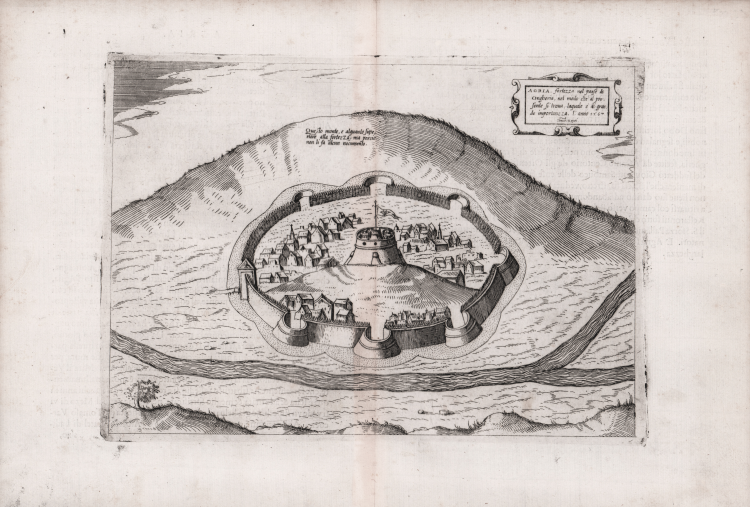



| Reference: | MS7268 |
| Author | Domenico ZENOI |
| Year: | 1567 ca. |
| Zone: | Eger |
| Printed: | Venice |
| Measures: | 275 x 196 mm |


| Reference: | MS7268 |
| Author | Domenico ZENOI |
| Year: | 1567 ca. |
| Zone: | Eger |
| Printed: | Venice |
| Measures: | 275 x 196 mm |
Map of Eger, signed by Domenico Zenoi.
The map was first published in the incredible rare Paolo Forlani’s town book "“Il primo libro delle citta, et fortezze principali del mondo", published in 1567 with a partnership of Domenico Zenoi.
The plates then comes in the hand of the publisher Bolognino Zaltieri and published in the De’ disegni delle più illustri città e fortezze del mondo", by Giulio Ballino, in 1569.
Giulio Ballino was a Venetian lawyer, a friend of the Manuzio family, really fond of classical studies.
His work is the first attempt, in Italy, to realize an atlas/text of the main fortresses and cities in the world. Unlike his predecessors, from whom he copied the iconography, Ballino wanted to realize a complex work, with text and an index, so that the reader could know immediately how many works were inside the book. Following Du Pinet’s Plantz, Pourtraitz et descriptions de plusieurs ville set forteresses.. Ballino’s work is, with all probability, just the first part of an ambitious, bigger project. May be he wanted to publish a Latin edition, hoping to give his book great fame along Europe, but he had to change his mind when Georg Braun & Fransz Hogenberg published their Civitates Orbis Terrarum, which was then the first book to describe urban iconography.
Ballino’s plates have been issued between 1566 and 1568; according to Albert Ganado (1993), 32 of these happen to be reprints of Forlani & Zenoi’s branches, already published for the first time in Il primo libro delle città, et fortezze principali del mondo (1567); the plates of these engravings have been afterwards modified. Some of them have been published in Bertelli’s Disegni di alcune più illustri città di fortezze del mondo con aggiunte di alcune isole principali, (1568).
Some examples of this rare work bear an allegorical title page, engraved by the Venetian artist Nicolò Nelli, a popular engraver of the XVI century; other examples bear a blank title page. Both versions have been printed by Zaltieri in 1569. It is quite hard to say which is the first version and which the last one, for the only difference is on the text on verso, with bigger letters in one case.
Another difference is that some of the maps in one version have numbers on verso. We might say that those examples without numbers have been printed first, but the analysis of the engravings doesn’t support this theory.
The engravings listed hereby come from a defective edition; for preciseness of information, we must add that the authorship of every work has been given to the artist that realized it, even if all of them come from Ballino’s collection.
Copperplate, full wide margins, in excellent condition. Rare.
|
Szalai Béla (2001): p. 61, tav. 89, n. 1567/1 & 1569/1 & 1596/1.
|
Domenico ZENOI (Attivo tra il 1559 e il 1574)
|
Engraver, goldsmith and publisher. Active in Venice and Padua. Fifteen-year privilege granted by the Senate, 5 december 1566 for devotional prints, portraits and maps that he intended to publish. A license was issued to Zenoi on the same day by chiefs of the Council of X. A month later, 11 January 1567, a second license with stipulation that Zenoi required to show each print to the Esecutori contro la bestemmia so that they could check there was no obscenity. 9 september 1568 fined, with Camocio, by the Esecutori for obscene prints and sonnets found in Camocio's shop. His plates were published by, among others, Donato e Ferrando Bertelli, Bolognino Zaltieri, Pierre de Huchin.
|
|
Szalai Béla (2001): p. 61, tav. 89, n. 1567/1 & 1569/1 & 1596/1.
|
Domenico ZENOI (Attivo tra il 1559 e il 1574)
|
Engraver, goldsmith and publisher. Active in Venice and Padua. Fifteen-year privilege granted by the Senate, 5 december 1566 for devotional prints, portraits and maps that he intended to publish. A license was issued to Zenoi on the same day by chiefs of the Council of X. A month later, 11 January 1567, a second license with stipulation that Zenoi required to show each print to the Esecutori contro la bestemmia so that they could check there was no obscenity. 9 september 1568 fined, with Camocio, by the Esecutori for obscene prints and sonnets found in Camocio's shop. His plates were published by, among others, Donato e Ferrando Bertelli, Bolognino Zaltieri, Pierre de Huchin.
|